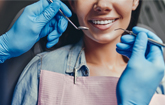CHICAGO, Oct. 7, 2013 /PRNewswire-USNewswire/ -- The American Academy of Pediatric Dentistry (AAPD), the leading authority on children's oral health, is reminding parents and caregivers that moderation is the key in keeping children, and their mouths, healthy for the Halloween holiday. According to an October 31, 2012 info graphic from Retail TouchPoints, "Americans spend nearly $2 billion on Halloween candy, which makes up 8% of the U.S. sweet sales." Given the popularity and prevalence of candy during the Halloween holiday, it's important for parents and caregivers to remember that sweet treats can sometimes lead to cavities and poor dental health.
(Logo: http://photos.prnewswire.com/prnh/20100222/AAPDLOGO)
"If children do not snack often, there is no food that is really bad for their teeth," said Dr. Warren Brill, president of the American Academy of Pediatric Dentistry (AAPD). "In fact, many parents may not realize that children's dental health depends less on what they eat and more on how often they eat it."
Brill recommends choosing candy or sweets that are eaten quickly, rather than something that stays in the mouth. "The important thing with sweets is how long the sugar sits in the mouth," he stated. "The sugar turns into acid and demineralizes teeth."
Contrary to popular opinion, dentists do enjoy the Halloween holiday and the AAPD has offered a few simple tips on how to keep little mouths healthy this Halloween:
- Snack in moderation, no more than three times a day. If possible, brush afterwards and if that is not possible, swish with water to help clean the mouth so that food does not stay on the teeth, which allows more acid production by the bacterial plaque that coats the teeth and leads to decay.
- A food with sugar or starch is safer for teeth if it is eaten with a meal, not as a snack.
- Brush for two minutes, twice a day. The best times to brush are after breakfast and before bed. Parents should supervise the brushing for school-age children until they are seven to eight years of age (about the same time they can tie their own shoelaces or write in cursive).
- The best toothbrushes have soft, round-ended (polished) bristles that clean while being gentle on the gums. The handle should be the correct size to fit your child's hand.
- If your child hasn't been to the dentist in a while or ever, this is a great time to make an appointment -- while candy is on the brain. The earlier dental care is started, the less likely serious problems are to emerge. A pediatric dentist can help your little one develop good dental practices at home.
"At the end of the night, children should brush and floss, or at the minimum rinse with water. It is letting the candy stay on the teeth that can lead to dental decay," said Brill.
For more helpful tips to ensure that your family enjoys a fun and healthy Halloween, please visit http://mychildrensteeth.org.
About the American Academy of Pediatric Dentistry
The American Academy of Pediatric Dentistry is the recognized authority on children's oral health. As advocates for children's oral health, the AAPD promotes evidence-based policies and clinical guidelines; educates and informs policymakers, parents and guardians, and other health care professionals; fosters research; and provides continuing professional education for pediatric dentists and general dentists who treat children. Founded in 1947, the AAPD is a not-for-profit professional membership association representing the specialty of pediatric dentistry. Its 8,800 members provide primary care and comprehensive dental specialty treatments for infants, children, adolescents and individuals with special health care needs. For further information, visit the AAPD website at http://www.aapd.org or the AAPD's consumer website at http://www.mychildrensteeth.org.
SOURCE American Academy of Pediatric Dentistry
WANT YOUR COMPANY'S NEWS FEATURED ON PRNEWSWIRE.COM?
Newsrooms &
Influencers
Digital Media
Outlets
Journalists
Opted In





Share this article